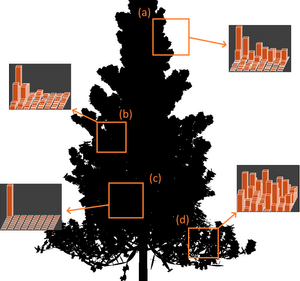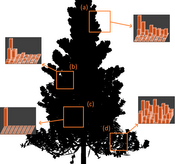Information
- Publication Type: Bachelor Thesis
- Workgroup(s)/Project(s):
- Date: July 2022
- Date (Start): 1. January 2022
- Date (End): 15. July 2022
- Matrikelnummer: 01518693
- First Supervisor:
- Keywords: rendering, occlusion culling, real-time
Abstract
To increase rendering efficiency of large and complex scenes, occlusion culling algorithms detect objects which are completely hidden by others and therefore do not need to be rendered. However, these methods often follow an all-or-nothing principle, either culling the geometry entirely or drawing it at full detail. This approach disregards an important subcategory of the visibility problem: detecting objects that are hardly visible because they are partly occluded and which can therefore be rendered at a lower level of detail without generating noticeable artifacts. In this thesis we assess the level of visibility of such objects by computing a hierarchical occlusion map and analysing its structure based on the frequencies of the occluders. This analysis results in a parameter that controls the level of detail (LOD) in which the geometry is rendered. The algorithm performs well even in scenes with sparse occlusion, surpassing the standard hierarchical occlusion map algorithm, with still a lot of potential for even further improvements.Additional Files and Images
Weblinks
No further information available.BibTeX
@bachelorsthesis{kristmann-2022-occ,
title = "Occluder Frequency Analysis for Evaluating the Level of
Visibility of Partly Occluded Objects",
author = "Elias Kristmann",
year = "2022",
abstract = "To increase rendering efficiency of large and complex
scenes, occlusion culling algorithms detect objects which
are completely hidden by others and therefore do not need to
be rendered. However, these methods often follow an
all-or-nothing principle, either culling the geometry
entirely or drawing it at full detail. This approach
disregards an important subcategory of the visibility
problem: detecting objects that are hardly visible because
they are partly occluded and which can therefore be rendered
at a lower level of detail without generating noticeable
artifacts. In this thesis we assess the level of visibility
of such objects by computing a hierarchical occlusion map
and analysing its structure based on the frequencies of the
occluders. This analysis results in a parameter that
controls the level of detail (LOD) in which the geometry is
rendered. The algorithm performs well even in scenes with
sparse occlusion, surpassing the standard hierarchical
occlusion map algorithm, with still a lot of potential for
even further improvements.",
month = jul,
address = "Favoritenstrasse 9-11/E193-02, A-1040 Vienna, Austria",
school = "Research Unit of Computer Graphics, Institute of Visual
Computing and Human-Centered Technology, Faculty of
Informatics, TU Wien ",
keywords = "rendering, occlusion culling, real-time",
URL = "https://www.cg.tuwien.ac.at/research/publications/2022/kristmann-2022-occ/",
}


 thesis
thesis
